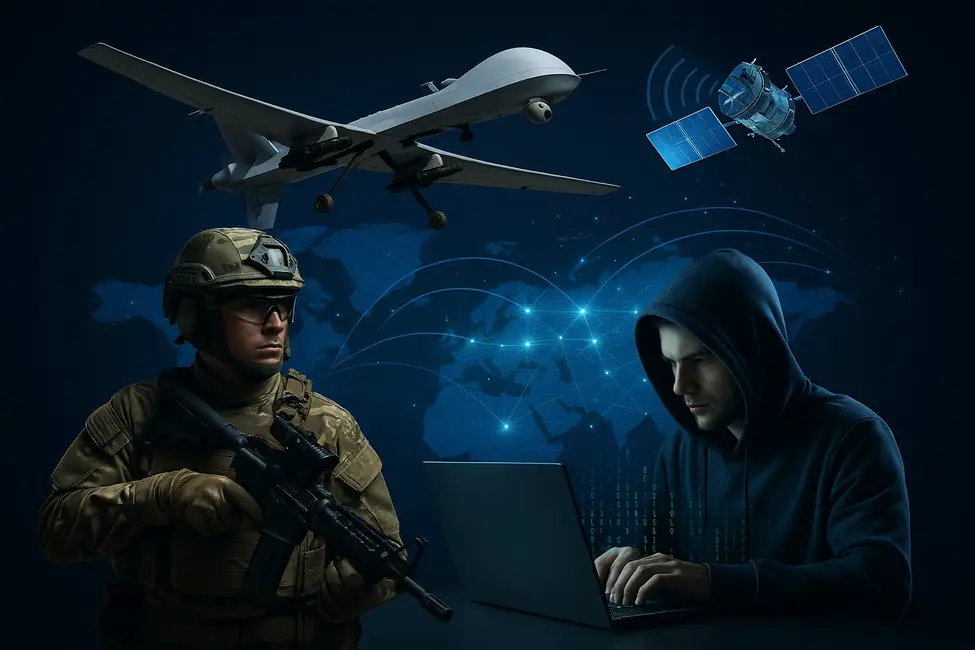Theme:
- In earlier times, wars were fought on battlefields using tanks, guns, and large armies. But today, warfare has gone far beyond physical borders. Modern conflicts involve cyberattacks, fake news, economic pressure, and even satellite disruptions. As warfare continues to evolve, it now includes different types of battles happening at the same time.
How warfare is changing:
- After the Cold War, large-scale world wars have become less common. However, smaller regional wars have continued, and they are now fought with smarter strategies and high-tech weapons. For example, in the 1991 Gulf War, the United States used satellite-guided bombs and advanced surveillance systems instead of just sending in troops.
- Cyber warfare is one of the biggest game changers in modern times. Nations and hacker groups are now attacking power grids, banks, defence networks, and even election systems using digital tools. In 2024, Ukraine experienced widespread blackouts due to cyberattacks on its power sector. Similar threats have been reported in India and the U.S., where hackers used artificial intelligence to create targeted phishing attacks.
- Hybrid warfare is another modern strategy. This method combines traditional military action with cyberattacks, fake news campaigns, and economic sanctions. Russia’s involvement in Ukraine is one of the most well-known examples of hybrid warfare in recent years. The conflict has involved not just military invasion but also disinformation on social media and attacks on Ukraine’s cyber infrastructure.
- Information warfare has also become more common. In this method, countries spread fake news and misleading information to confuse people or turn them against their own governments. During the Gaza conflict, both Israel and Hamas were accused of using AI-generated videos and fake stories to control global opinion.
- Warfare today is not limited to land, air, or sea. It now includes even outer space. This is known as multi-domain warfare. Countries are developing weapons that can disable enemy satellites or jam communication systems. The US has expressed concern over China’s increasing military activity in space and its potential to interfere with US satellites using lasers.
- Asymmetrical warfare is when smaller groups, such as terrorist organizations or rebels, use surprise tactics to fight larger, more powerful countries. The Houthi rebels in Yemen have used cheap drones to attack oil fields and disrupt ships in the Red Sea. These kinds of attacks are low-cost but highly effective.
- Economic warfare is also part of modern conflict. Countries are now using trade bans, sanctions, and financial tools to hurt other nations economically. For example, after the invasion of Ukraine, Western countries imposed strict economic sanctions on Russia to pressure it to stop the war. These sanctions impacted Russia’s economy.
India’s preparedness to changing warfare:
- India has been taking steps to adapt to these modern threats. Organisations like CERT-In and the Defence Cyber Agency are working to protect the country from cyberattacks. India also launched a National Cyber Security Strategy in 2024, which aims to strengthen digital infrastructure and train professionals in cybersecurity. At the same time, ISRO and DRDO are developing space-based defence systems to keep the country prepared for new-age threats.
Challenges:
- There are several challenges in dealing with this new style of warfare. One major issue is the lack of clear international laws to regulate cyberattacks and digital warfare. Unlike traditional war, where rules are defined, cyber warfare often goes unpunished because attackers can easily hide their identity.
- Misinformation is another serious problem. False news can spread quickly on social media and cause panic or division among people. Many citizens are still unaware of how to verify information online, making them easy targets for manipulation.
- Modern wars can also begin silently. A country might face cyberattacks or information warfare without even knowing who the enemy is. This makes it harder to respond and defend.
Way forward:
- To face these modern challenges, countries need to work together and create international rules for cyber warfare and information attacks.
- Defence strategies should include protection in all areas – land, sea, air, cyber, and space.
- Governments should also run public campaigns to teach people how to spot fake news and stay safe online.
- Investing in artificial intelligence, satellite security, and ethical hacking is also important. At the same time, countries should use diplomacy and peaceful solutions whenever possible to avoid war altogether.
Conclusion:
The nature of warfare has changed completely. Modern conflicts may not begin with bombs or guns, but with a power failure, a viral fake video, or a crashing economy. As warfare continues to evolve, both governments and people must stay alert, learn new skills, and adapt to the changing world. Peace and safety will depend not just on traditional military, but also on cybersecurity experts, informed citizens, and strong international cooperation.
Your Turn…
What’s your take on the changing nature of warfare? Express your point of view through the comment section below. And subscribe to our blog to read answers to the trending GD topics.
References:
Copyright @ Group Discussion Ideas.

